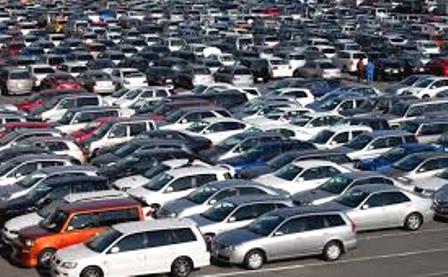Vehicle News, The Auction
In this posting we will venture slightly outside the usual realm of discussing junk vehicle removal, the auto junk business and the value of a junk car. We buy scrap cars and are primarily involved in working with end-of-life vehicles (ELV). The life span of car in the US can range from 10 to 20 years; therefore, there are various sequences in a vehicle’s useful life span, long before they would be considered auto junk and processed for junk vehicle removal. One aspect of vehicle ownership is the realization of depreciation. A vehicle ages (year after year) and accumulates additional mileage, its market value declines, until ultimately it is the value of a junk car. In this post we examine a “mid-point” within the vehicle life cycle, when it is resold at an auction. W. Christian Ward composed an article in roadandtrack.com titled ‘Here’s What Happens During One Day at an Auto Auction’ on October 22, 2015 with the following information: “It’s a hot day at the ADESA auto auction of Atlanta. The facility has its own detailers, servicemen, and auctioneers. It’s the 3rd largest in the city; more than 1200 cars will be up for sale. The doors open at 8:30 and the machinery is spinning by 9:30. The auction starts with three lanes. By 10:15, six of the eight available lanes are going. The uniform of today’s buyer is a plain T-shirt or polo. The whole event has the air of a company golf outing. Despite the heat, ADESA employees are meticulously groomed. The ladies are in full makeup and jewelry, the males clean-shaven.
The buyers are independent car dealers. They use smartphone apps to scan VINs. The sellers are new-car dealers liquidating trade-ins, credit unions, leasing companies, fleet owners, and rental agencies. The raised auction platforms sit alongside the lanes. Bidders gather between the lanes, facing the auctioneer and standing back-to-back with the bidders from the next lane. There is usually a seller’s representative to approve the final bid. The ringmen, work the crowd and hype the cars. They hold a rolled hardcopy of the lane’s wares & slap it against their open hand or on the windshield with every bid increase. The cars are not obvious bargains. Independent dealers are blue-collar and competition is fierce, and profits are small. In the hectic pace, a clean 2003 Explorer Sportrack sells for $1300 in less than a minute. Six feet away a 2003 Lexus LS430 sells for $5600. Clifford McGhee, a dealer from Decatur, picks up a 2008 Mercedes S500 for $7000. He is pleased with the deal and says he’ll make about $2000. (gross, not net) He has to get the car to his lot, cover overhead, and hope the car doesn’t have a fatal flaw. He’s spent decades building an honest reputation. One bad purchase can put him in the red for the month.
The auction appears chaotic at first, but is highly orchestrated. Buyers know their customer’s taste & usually specialize in a few brands. Toyotas & Hondas still command top dollar. It is easy to see what manufacturers had the most attractive leases 3 years ago. There’s an abundance of Lexus’, BMWs, and Jeep Patriots. Each lane has a snack & drinks table. In addition to the buyers in attendance, every lane simulcasts online. If you are a larger dealer looking to build inventory, you can log onto auction’s website and bid in real time. You lose the benefit of seeing the cars up close, but you can attend several auctions at once. Potential buyers inspect paint and scan VINs. At 11:00, a fleet company liquidating cars has a drawing for a free TV—must be present to win. The auction provides the venue & the buyers, but it doesn’t own a single car. To keep bidders around and buying, sellers incentivize the crowd. Tickets & gift cards are common prizes. By 11:30 over 1100 cars have sold and now the hard-to-sell vehicles begin to cross. Most are too expensive or past their prime. A Chrysler dealer auction opens, separate from the main event.. It’s 12:15 and the final car, a 2000 Infinity I30, goes unsold. Minutes later janitors mop the deserted lanes. The staff retreats to their offices. These are bids that came close but outside of the dealer representatives’ ability to accept. The staff calls their contacts at the seller’s offices and let them know what the last bid was. There are more than 100 of these to close, and these cars have to go. The auction makes about $330 per car, but each time an employee washes, moves, or fixes a car, ADESA spends an average of $10. Vehicles remaining another week quickly marginalize profit. Sellers want these cars gone–transporting them back & forth gets expensive. 56% of the cars on the block were sold today. The staff will be here cleaning and wrapping up. They have 4 days to prepare-then the show happens again.” Here is the link to the complete article.
We Buy Scrap Cars!
Hopefully this brief glimpse at how auto auctions operate is informative to those seeking to understand the many aspects of the US auto industry. Next, we will get back to our small segment of the industry—dealing in auto junk and recycling. Barberton Junk Cars will buy scrap cars throughout Summit, Medina and Portage Counties 6 days a week. Junk vehicle removal is included in the price regardless of the value of a junk car. When seeking a buyer of scrap cars, or a “cash for my car” hauler, ask if they are a reputable company. Do they have a website and track record in the business? We pay fast cash for cars throughout Cuyahoga Falls, Tallmadge and the Portage Lakes. We buy scrap cars in any condition in Barberton, Copley and Norton. Residents in the areas of Springfield Township, Mogadore and East Akron are encouraged to call (330) 732-JUNK for a junk car quote. Even if your car is broken down at a repair shop in Ravenna, Merriman Valley or Bath—we will pick it up!


 using WordPress and
using WordPress and
Comments are closed